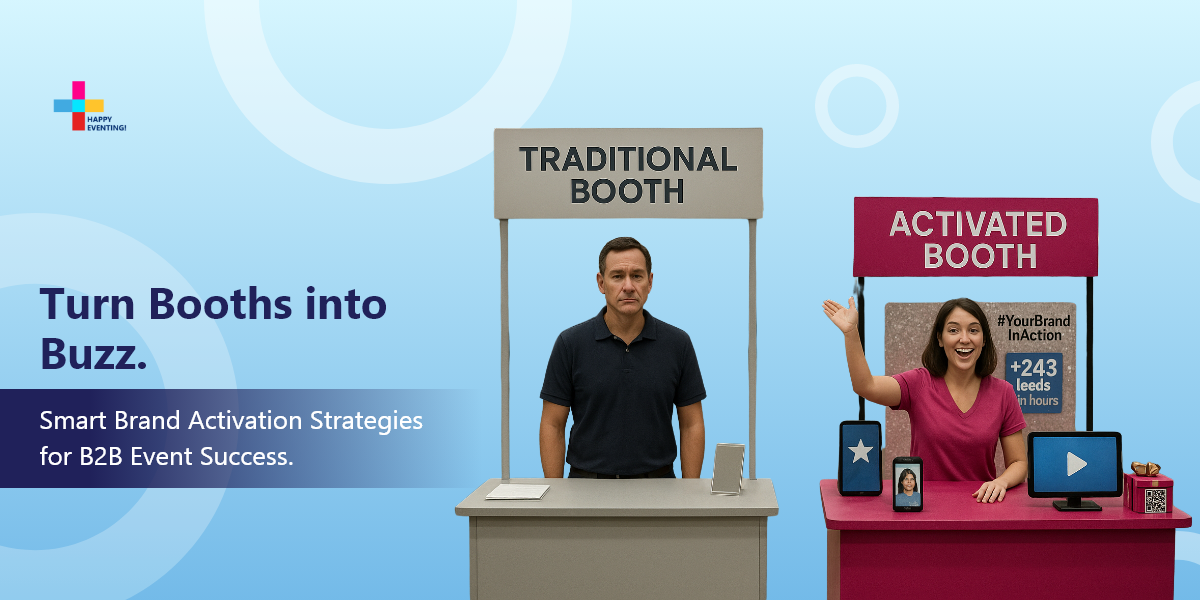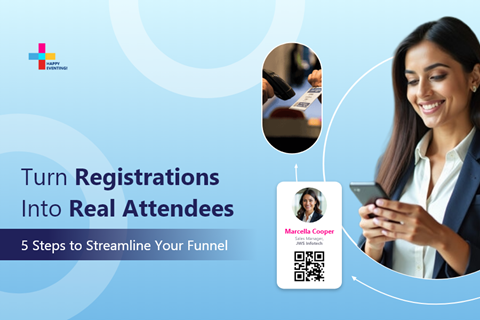

- {{UserName()}}
Request a Demo




Brand presence is easy. Brand impact takes strategy.
That’s where brand activation comes in. It pulls in decision-makers, creates hands-on engagement, and converts event buzz into a pipeline.
Static booths don’t cut it. Strategic experiences showcase your value, capture intent signals, and lead directly to follow-up conversations. That’s how brands build credibility and accelerate deal velocity on the event floor.
Whether you're a CMO, event strategist, or part of a revenue team, this guide breaks it all down: what brand activation means, how it works at B2B events, and the strategies and formats that move the needle.
Brand activation is a marketing strategy that builds a strong brand presence or re-engages audiences through interactive, experience-driven tactics. As a popular strategy used in B2B events, it directly engages key decision makers like CMOs, procurement officers, and department heads through hands-on experiences. These experiences are designed in a way that clearly demonstrates your brand’s value, build trust, and establish credibility.
Brand activation turns exposure into measurable outcomes. It accelerates pipeline growth, strengthens executive relationships, and builds brand equity. For CMOs focused on results, activations deliver clear ROI and brand impact.
Here are the key benefits and what they unlock:
|
Benefit |
How It Impacts Events |
|
Standout Presence |
Grabs attention and cuts through competing noise with a clear, memorable brand impression |
|
Pipeline Growth |
Captures high-intent leads that are easier to qualify and quicker to convert |
|
Brand Loyalty |
Creates authentic experiences that build long-term trust with decision-makers |
|
Faster Deal Velocity |
Surfaces real buyer interest and shortens the time between first touchpoint and sales conversation |
|
Higher ROI on Spend |
Ties every activation element to measurable outcomes, helping justify spend with data-backed results |
|
Content Generation |
Produces sharable, real-time content that supports broader marketing efforts across channels |
|
Competitive Differentiation |
Demonstrates your value in action, giving prospects a reason to choose you over similar vendors |
When done right, brand activation becomes more than an experience. It’s a strategy that helps accelerate business growth.
B2B events are high-stakes environments. You’re competing for attention, relevance, and trust, all in a limited timeframe. Brand activation helps you win on all three.
When decision-makers walk the floor, they’re not looking for swag, they’re looking for solutions. A strategic activation meets that moment head-on.
Here’s how it drives value across the event lifecycle:
Before the Event
Targeted activations create anticipation and generate buzz with pre-event campaigns, exclusive sneak peeks, or invite-only previews.
During the Event
Onsite engagement formats like interactive demos, pop-up experiences, or curated lounges help you stand out while delivering real business conversations.
After the Event
Data collected during activations powers smarter follow-ups. It gives your sales team context, intent signals, and warm paths into accounts.
Strategic activations don’t just engage. They influence pipelines, accelerate deals, and build brand affinity that lasts.
You’ve seen the benefits. You understand the strategic importance across the event journey. Now let’s break down how brand activation creates real momentum on the floor.
Brand activation amplifies visibility through intentional, well-placed high-impact setups such as interactive booths, pop-up showcases, and demo stations. These environments generate content-worthy moments. Whether through branded hashtags or influencer shoutouts, your visibility extends beyond the booth and into the digital space.
To extend this visibility further, brands use micro activations. These are lean, intentional setups that spark attention without draining the budget.
Example: A cybersecurity company creates a 3-minute “hack the firewall” challenge at a tech event, turning booth visits into shareable moments on LinkedIn.
Pro Tip: Use your event platform’s analytics module to track booth traffic peaks, most-viewed content, and social post engagement in real time.
Brand activations allow for personalized, value-driven experiences that create real trust with enterprise buyers. From private lounges to live strategy consults, these touchpoints give decision-makers the confidence to move forward.
Behavioral data like time spent at a station or interest in specific topics helps your team follow up with more relevant conversations.
Personalization shows a deep understanding of each decision-maker's priorities.
Example: A cloud infrastructure firm offers tailored architecture reviews on-site for CTOs and VPs of Engineering, using pre-event survey data to guide the session.
Pro Tip: Leverage AI-based matchmaking tools within your event app to identify top prospects and automatically schedule consultations during available windows.
Great activations outperform static displays by turning interest into action. Whether it's through lead capture kiosks, content selection data, or product engagement analytics, activations give your team more than just names—they deliver insights.
This data helps sales prioritize leads based on actual behavior, not just badge scans.
Interactivity delivers a dual impact—showcasing your solution while capturing valuable data.
Example: An AI software provider runs a guided use-case tour that tracks which solutions each visitor explores. The data is synced to the CRM to score leads and shape outreach.
Pro Tip: Connect badge scanning tools or interactive displays directly to your CRM to auto-score leads and trigger real-time sales alerts during the event.
Brand activations succeed when they embody your value proposition. Messaging must be sharp, strategic, and tied directly to pain points like productivity or digital transformation.
Checklist:
Know your audience before you engage with them. Buyer personas sharpen your focus. For instance, executives in healthcare want compliance, while manufacturing heads focus on efficiency.
Checklist:
Brand activation without goals is noise. Whether driving MQLs, nurturing accounts, or launching products, clear objectives ensure alignment and accountability.
Checklist:
Creativity and relevance unlock engagement. AR simulations, pop-up R&D labs, or QR-based experiences give decision-makers more than a pitch. They show real use cases.
Checklist:
Treat execution like a live product demo—every element reflects your brand’s reliability. Test your Wi-Fi, prep your team, and make sure all tech integrations run without a hitch.
Checklist:
Amplify before, during, and after. Drive traffic with strategic email campaigns, real-time updates via event apps and branded hashtags to drive awareness and post-event engagement.
Checklist:
These aren’t generic tactics. They’re precision-calibrated strategies designed to engage executives and convert influence into outcomes.
|
Strategy Type |
What It Does |
When to Use It |
|
Experiential Marketing |
Creates immersive, memorable environments that emotionally connect with attendees. |
Best for showcasing innovation and complex solutions through interaction. |
|
Sponsorship Activation |
Integrates your brand into the fabric of the event through branded environments or utilities. |
Ideal for large industry events with pre-existing audience attention. |
|
Digital Campaigns |
Drives engagement through online channels like webinars, social media, and email. |
Use when extending activation before or after the physical event. |
|
Guerrilla Marketing |
Delivers surprise through unconventional, low-cost tactics that grab attention fast. |
Works well at high-traffic venues where creativity beats budget. |
|
Pop-Up Experiences |
Provides temporary installations that spark curiosity and offer hands-on product moments. |
Great for spotlighting new products or entering a new market. |
|
Influencer Partnerships |
Leverages industry thought leaders to boost credibility and drive engagement. |
Effective when trying to reach niche audiences or skeptical buyers. |
|
On-Site Engagement |
Facilitates direct interaction through kiosks, lounges, and demos at the venue. |
Essential when in-person lead capture and relationship-building are priorities. |
These tactics are engineered for impact. They attract senior decision-makers, generate qualified leads, and position your brand as a solutions-driven authority.
Guide attendees through your product with short, hands-on sessions that focus on real business use cases. These walkthroughs demonstrate value clearly and boost buyer confidence.
Host expert-led sessions that tackle relevant industry topics like compliance or automation. These panels position your brand as a leader and attract high-level decision-makers.
Use virtual reality to simulate product environments or workflows. This format delivers a unique experience while helping attendees grasp your solution’s practical benefits.
Design relaxed spaces where professionals can connect and talk shop. These lounges offer high-value conversations while keeping your brand front and center.
Incorporate quizzes, challenges, or contests to educate while entertaining. This approach keeps energy high and captures useful data on attendee interests.
Feature short videos or live storytelling sessions that highlight client success. These examples offer proof of performance and make your solution easier to trust.
Set up digital kiosks where attendees can share business goals and challenges. Deliver instant value through tailored content while capturing high-quality leads.
Create temporary showcases for prototypes, tools, or experimental features. These hubs attract forward-thinking attendees who want to see what’s next.
Offer scheduled consults where subject matter experts address specific challenges. These focused conversations often lead to stronger follow-up and deeper interest.
Display live attendee posts tagged with your event hashtag. These walls encourage participation, boost visibility, and extend your reach beyond the venue.
Run interactive sessions that teach attendees how to use your product in practical scenarios. This helps reinforce your value and increase buyer understanding.
Organize private dinners or exclusive meetups for top clients and prospects. These events build stronger relationships and create room for strategic conversations.
While executing your strategy, it’s just as important to measure if your brand activation is delivering results. Success goes beyond surface-level stats. It’s about tracking a mix of tangible KPIs and human insights that reveal the true impact of your efforts. The points below help you evaluate both.
Engagement metrics like dwell time, conversion rates, lead quality, and content interaction give you a fuller picture of what’s working. Complete reporting and analytics generated by efficient event management software allow your team to adapt and improve at the moment.
Sometimes, the most valuable insights come from conversations. Post-event feedback, especially from decision-makers, reveals how your brand made people feel. These reflections help you refine messaging and plan smarter for the next event.
When your activation goals are tied to business priorities from the start, ROI becomes easier to track and prove. Define what success looks like before the event—whether that’s high-quality leads, faster deal cycles, or increased pipeline. Then use metrics like cost-per-lead, conversion rates, and influenced revenue to measure what matters.
You now have the playbook. The most effective brand activations start with a clear strategy and end with measurable outcomes. Intentional execution doesn’t just draw attention, it signals that your brand leads the conversation. You don’t need oversized booths or flashy gimmicks. You need purpose, precision, and the right partner.
Start now. Plan with intent and let Eventcombo streamline your activations while driving stronger business results.

Brand presence is easy. Brand impact takes strategy. That’s where brand activation comes in. It pulls in decision-makers, creates hands-on engagement, and converts event buzz into a pipeline. Static booths don’t cut it.

Imagine turning an ordinary sidewalk into the most talked-about brand stage of the season. That's the power of a pop-up event. Temporary, nimble, and strategically deployed, pop-ups are no longer just a trend—they've...

Let’s be honest: there was a time when great content and a catchy title were enough to pull in a crowd. But today, events have become a go-to marketing play, and now, everyone’s in the game.